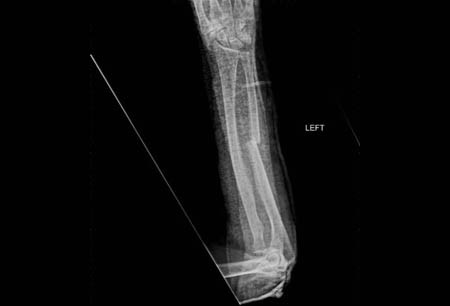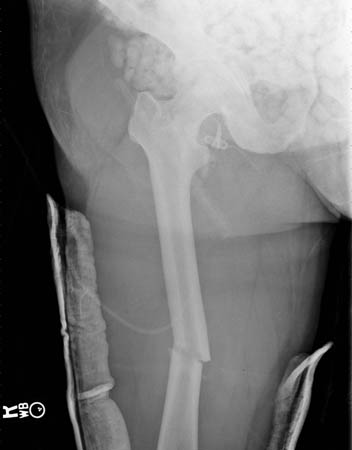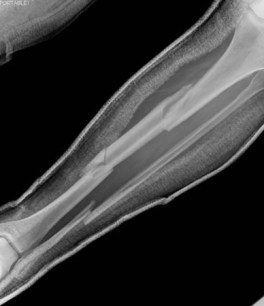Tests
1st tests to order
x-ray limb
Test
At least two 90° orthogonal views, including visualization of the joint proximal and distal to the area of suspected injury. Limited sensitivity in early stress fractures and in older patients with underlying osteoporosis.[1] Effective screening tool if symptoms have been present for at least 10-14 days.[1][59][Figure caption and citation for the preceding image starts]: X-ray showing osteoporotic ulnar fracture involving the proximal third of the shaft with associated dislocation of the radial head at the elbow (Monteggia fracture)From the personal collection of Dr Philip H. Cohen [Citation ends]. [Figure caption and citation for the preceding image starts]: X-ray showing midshaft femur fractureFrom the personal collection of Dr Philip H. Cohen [Citation ends].
[Figure caption and citation for the preceding image starts]: X-ray showing midshaft femur fractureFrom the personal collection of Dr Philip H. Cohen [Citation ends]. [Figure caption and citation for the preceding image starts]: X-ray showing a segmental fracture of the tibia and fibulaFrom the personal collection of Dr Philip H. Cohen [Citation ends].
[Figure caption and citation for the preceding image starts]: X-ray showing a segmental fracture of the tibia and fibulaFrom the personal collection of Dr Philip H. Cohen [Citation ends].
Result
fracture and associated joint disruption
CBC, blood typing, and cross-matching (major trauma)
Test
Worrisome for massive bleeding, especially in cases of acute femoral fractures. In setting of major trauma, needs to be performed as part of initial evaluation.
Result
may show acute drop in hematocrit
Tests to consider
MRI of area of interest without IV contrast
Test
Excellent sensitivity and specificity for stress fractures, without the ionizing radiation of a bone scan. Useful in patients with suspected stress fractures and negative or indeterminate radiographs including in patients at high risk for fracture completion (e.g., patients with osteoporosis on bisphosphonate therapy).[1] Can determine extent of fracture and associated complications and can also be used for definitive diagnosis of more subtle fractures.[1]
Result
fracture line, disruption of bony architecture and/or articular surface, associated soft tissue injury
noncontrast CT of fracture
Test
Excellent depiction of bony anatomy. Helps to determine severity and exact nature of injury if not seen well or equivocal on plain x-rays or MRI; may be useful for determining extent or associated complications of stress fractures and for preoperative planning.[1]
Three-dimensional CT reconstruction has been advocated as a way to better visualize the exact anatomy of proximal humeral shaft fractures.[61]
Result
fracture details
whole body bone scan with SPECT or SPECT/CT area of interest
Test
May be useful for early detection of stress fractures.[1]
If the clinical presentation is suspicious for a stress fracture but the x-rays are negative, a bone scan can be obtained. Stress fractures are frequently evident days to weeks earlier on bone scans than radiographs.[1] If the bone scan reveals focal, increased uptake at the area of suspicion, this is consistent with a stress fracture. In older patients or patients with osteoporosis, abnormalities may not show up on bone scintigraphy for several days after the injury.[1] Patients using corticosteroids may also have less sensitive bone scintigraphy results.[1][60]
Result
focal area of increased uptake
compartment pressure testing
Test
If the exam is equivocal or diagnosis is unclear, then there is a role for pressure measurement.[54][58] However, pressure should not be relied upon to rule out acute compartment syndrome if the clinical picture is consistent with a compartment syndrome. See Compartment syndrome of the extremities.
Result
elevated pressures in acute compartment syndrome
Doppler pressure (ankle/brachial systolic pressure index)
Test
Used to assess for vascular injury, and often utilized prior to angiography.
Performed after x-rays, but must be done quickly if vascular injury is suspected.
Result
reduced pressures according to site of vascular injury
ultrasound duplex scanning
Test
Used to assess for vascular injury, and often utilized prior to CT angiogram or conventional angiography.
Performed after x-rays, but must be done quickly if vascular injury is suspected.
Result
thrombosis, impaired flow at site of vascular injury
CT angiogram
Test
Confirms clinical suspicion of vascular injury. CT angiogram has largely supplanted the use of conventional angiography in assessing suspected vascular injury.
Result
thrombosis, extravasation, impaired flow at site of vascular injury
angiography
Test
Confirms clinical suspicion of vascular injury if CT angiogram is not available.
Performed after x-rays but must be done quickly if vascular injury is suspected.
Result
thrombosis, extravasation, impaired flow at site of vascular injury
dual-energy x-ray absorptiometry bone density scan
Test
Patients suspected of having osteopenia/osteoporosis should undergo bone mineral density evaluation. However, if the dual-energy x-ray absorptiometry (DXA) scan measures the femoral neck after bony healing has occurred, a falsely normal or even high bone mineral density may be reported. Thus, the contralateral femoral neck should be used for the DXA if possible.
Result
bone density low in osteoporosis/osteopenia
whole-body CT
Use of this content is subject to our disclaimer